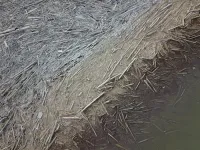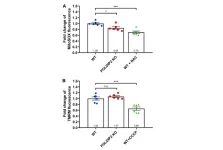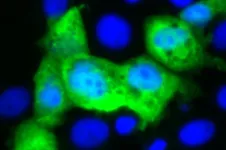(Press-News.org) WASHINGTON — Throughout the Arctic, fallen trees make their way from forests to the ocean by way of rivers. Those logs can stack up as the river twists and turns, resulting in long-term carbon storage. A new study has mapped the largest known woody deposit, covering 51 square kilometers (20 square miles) of the Mackenzie River Delta in Nunavut, Canada, and calculated that the logs store about 3.4 million tons (about 3.1 million metric tons) of carbon.
“To put that in perspective, that’s about two and a half million car emissions for a year,” said Alicia Sendrowski, a research engineer who led the study while at Colorado State University. “That’s a sizeable amount of carbon,” she said, but it’s not a carbon pool we know much about. “We have great knowledge about carbon in other forms, like dissolved or particulate organic carbon, but not what we call ‘large carbon’ — large wood.” That’s starting to change.
Scientists have known for decades that driftwood can really get around in the Arctic, but they are just beginning to quantify how much wood there is and how much of its carbon storage we risk losing to climate change. The Arctic’s cold, often dry or icy conditions mean trees can be preserved for tens of thousands of years; a tree that fell a thousand years ago might look just as fresh as one that fell last winter, Sendrowski said.
“There’s been a lot of work on fluxes of carbon from water and sediment, but we simply didn’t pay attention to the wood until very recently. This is a very young field of research that is developing quite fast,” said Virginia Ruiz-Villanueva, a fluvial geomorphologist at the University of Lausanne who was not involved in the study. “And it’s important to study this wood not only for the carbon cycle, but in general for our understanding of how these natural fluvial systems work, how the rivers mobilize and distribute the wood.”
The study was published in Geophysical Research Letters, which publishes high-impact, short-format reports with immediate implications spanning all Earth and space sciences.
To get a snapshot of the logjams, Sendrowski and her colleagues focused on the Mackenzie River, which has exceptionally high-resolution imagery available and is known to have large wood deposits. Its delta is the third largest in the world by land area and drains about 20% of Canada. The team studied about 13,000 square kilometers (5,000 square miles) of delta in the biggest attempt to map woody deposits so far.
The researchers spent three weeks in the field measuring river driftwood with colleagues at Colorado State University, mapping logjams and sampling the wood to date using radiocarbon dating. After fieldwork, Sendrowski used remote imagery to identify wood at the river’s surface and estimate the areal extent of the logjam. She then estimated the volume of wood within the logjam and how much carbon it’s storing, based on her field measurements.
Sendrowski found the deposit, comprising more than 400,000 miniature caches of wood, is storing about 3.4 million tons (3.1 million metric tons) of carbon. The largest single deposit, which covers around 20 American football fields, stores 7,385 tons (6,700 metric tons) of carbon alone. But because there are even more logs buried in soil, submerged underwater and hidden from aerial imagery under vegetation, the total amount of carbon stored in the delta’s wood could be about twice as large, she said.
The Mackenzie River Delta is a “hotspot” of carbon storage thanks to incredibly carbon-rich soils, Sendrowski said, so the logs’ carbon storage makes up a relatively small fraction of the delta’s total carbon storage, which is around 3 quadrillion grams of carbon. “But we think it’s still important because as changes in the basin occur, like logging or damming, and as climate change alters precipitation patterns and warming, wood preservation will decrease. It’s a significant amount of carbon, so there’s a potentially significant loss of carbon storage,” she said.
The Mackenzie logjam also reflects only one basin in the Arctic; at least a dozen deltas larger than 500 square kilometers dot the north, so all together, large woody deposits throughout the Arctic could add up to be a significant carbon storage pool, and one we know little about.
The researchers were also interested in how long a tree can last in the Arctic, which is important when modeling how “active” a carbon pool is — that is, how rapidly material is moved around. Carbon dating revealed that while many of the trees they sampled began growing around or after 1950, some were much older, reaching back to around 700 CE. (A study in the 1960s carbon-dated wood from a tree preserved in an icy mound to about 33,000 years ago.)
The Mackenzie River Delta was a good place to start. “The exciting aspect for me isn’t just the scale, but also the potential to apply this to other places where large wood hasn’t been focused on,” Sendrowski said. It’s a burgeoning field, she said, and there’s still much to be learned.
#
AGU (www.agu.org) is a global community supporting more than half a million advocates and professionals in Earth and space sciences. Through broad and inclusive partnerships, AGU aims to advance discovery and solution science that accelerate knowledge and create solutions that are ethical, unbiased and respectful of communities and their values. Our programs include serving as a scholarly publisher, convening virtual and in-person events and providing career support. We live our values in everything we do, such as our net zero energy renovated building in Washington, D.C. and our Ethics and Equity Center, which fosters a diverse and inclusive geoscience community to ensure responsible conduct.
###
Paper notes
“Wood-based carbon storage in the Mackenzie River Delta: The world’s largest mapped riverine wood deposit”
The study was published in Geophysical Research Letters, an open-access journal. View and download a free pdf of the study here.
Authors:
Alicia Sendrowski (corresponding author), Department of Civil and Environmental Engineering, Michigan State University, East Lansing, MI, USA; and Department of Geosciences, Colorado State University, Fort Collins, CO, USA. (Sendrowski is currently at Michigan Technological University.)
Ellen Wohl, Department of Geosciences, Colorado State University, Fort Collins, CO, USA
Robert Hilton, Department of Earth Sciences, University of Oxford, Oxford, UK
Natalie Kramer, Dipper and Spruce, LLC, White Salmon, WA, USA
Philippa Ascough, NRCL Laboratory, Scottish Universities Environmental Research Center, East Kilbride, UK END
According to Bening Mayanti's doctoral dissertation at the University of Vaasa, the use of life cycle assessment combined with economic models can help companies to take steps toward the circular economy.
– We often hear claims about some solutions being circular, sustainable, or green. Instead of blindly accepting those claims, we should ask justifications, ‘How so?’ says Mayanti, who publicly defended her dissertation on Wednesday, 5 April.
Before deciding on circular economy solutions and building supply chains, it is worth doing a careful analysis. ...
A new perspective published in the journal Nature Chemical Biology uncovers a previously unknown biochemical recycling process in animals. The authors review a flurry of recent papers demonstrating that animals extensively recycle biochemical waste to produce novel chemicals that play key roles in biology, from regulating behavior to development and aging.
These studies show that the genes previously thought to code for carboxylesterases, enzymes that hydrolyze esters, actually play a pivotal role in assembling a wide range of new metabolites from building blocks generally considered “cellular waste.” Surprisingly, the so-called carboxylesterases were found to contribute ...
Global supply chains are immense feats of technological and organizational sophistication. They are also, as the onset of the Covid-19 pandemic showed, vulnerable to unexpected developments. Will that change as artificial intelligence becomes a bigger part of supply chains? And what will happen to workers in the process?
MIT Professor Yossi Sheffi explores these topics in a new book, “The Magic Conveyor Belt: AI, Supply Chains, and the Future of Work,” published by MIT’s CTL Media. Sheffi, the Elisha Gray II Professor of Engineering ...
Oak Ridge National Laboratory researchers have developed an online resource to help consumers understand the electric vehicle tax credits available through the Inflation Reduction Act.
Located on the Department of Energy’s fueleconomy.gov website, the tool shows eligible vehicle models along with the corresponding federal tax credit.
The new clean vehicle tax credit is for purchases of all-electric, plug-in hybrid electric and fuel cell electric vehicles in 2023 and beyond. A separate credit is available for eligible used vehicles purchased in 2023 or after. Information on credits for vehicles purchased before ...
“To our knowledge, this is the first functional study of POLDIP2 in retinal cells to understand its potential role in AMD.”
BUFFALO, NY- April 11, 2023 – A new research paper was published in Aging (listed by MEDLINE/PubMed as "Aging (Albany NY)" and "Aging-US" by Web of Science) Volume 15, Issue 6, entitled, “Knockout of AMD-associated gene POLDIP2 reduces mitochondrial superoxide in human retinal pigment epithelial cells.”
Genetic and epidemiologic studies have significantly advanced our ...
Every year, norovirus causes hundreds of millions of cases of food poisoning — and the deaths of at least 50,000 children — yet there exists no real way to control it. The virus has proven exceptionally difficult to study in the lab, and scientists have struggled to develop effective vaccines and drugs.
A new study at Washington University School of Medicine in St. Louis describes a creative way to make a vaccine against norovirus by piggybacking on the highly effective vaccines for rotavirus, an unrelated virus that also causes diarrhea.
The ...
ITHACA, N.Y. – The demand for battery-grade lithium, nickel, cobalt, manganese and platinum will climb steeply as vehicle electrification speeds up and nations work to reduce greenhouse gas emissions through mid-century. This surge in demand will also create a variety of economic and supply-chain problems, according to new Cornell University research published in Nature Communications.
In the new paper, senior author Fengqi You, professor in energy systems engineering, and his colleagues examined 48 countries that are committed to playing a strong role in electrifying transportation, including the U.S., China and India.
Under ...
As announced today in a press release by biotechnology company Treventis, global pharmaceutical company Takeda has agreed to exclusively license a group of small molecules that target tau – a protein in which misfolding and aggregation are believed to be a cause of Alzheimer’s disease.
The molecules were developed by the team at Treventis, building upon the Alzheimer’s & neurodegenerative research expertise of Dr. Donald Weaver’s lab at UHN.
“There are currently no effective drugs out there that target tau in the brain,” says Dr. Donald Weaver, Senior ...
New York, NY (April 11, 2023) – A study led by Mount Sinai researchers Dr. Bin Zhang, the Willard T.C. Johnson Research Professor of Neurogenetics, and Dr. Christian Forst, an Associate Professor in the Department of Genetics and Genomic Sciences, have identified potential novel receptors for SARS-CoV-2 and unveiled their tissue-specific and age-dependent expression. The findings were published on March 23 in the Federation of European Biochemical Societies Letters.
The study's multiscale network analysis suggests that SARS-CoV-2 utilizes multiple novel receptors, such as the TYOBP receptor CD300e, to facilitate ...
North Carolina State University researchers have shown that adding a small amount of a chemical used in perfumes – nonanal – to a two-chemical combination of other sex pheromones helped increase the cocktail’s effectiveness in mimicking female fall armyworm “come hither” calls to males.
The findings could eventually help farmers better detect, monitor and control fall armyworm populations, which negatively affect some 350 plant species – including crops like corn and cotton as well as turfgrass and other cultivated grasses.
“Nonanal is emitted ...






